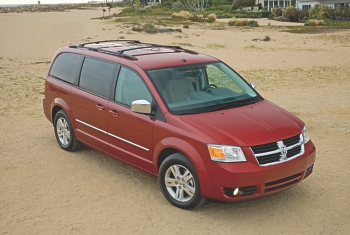
Automotive Intelligence - the web for automotive professionals and car enthusiasts
August 22, 2007
This Week:
-
Pebble Beach provided the stage for the all new Aston Martin DBS
-
GEM Zero Emission Vehicles winner of for Clean Air Leadership
-
Limited-edition of Lexus SC 430 made its debut at Pebble Beach Concours d'Elegance
-
Completely reworked Chevrolet Aveo will be presented in Frankfurt
-
C5 Airscape Concept gives an outlook of future Citroen C5 design
-
MINI John Cooper Works CHALLENGE, next season's MINI Challenge race car
-
All-New 2008 Honda Accord combines dynamic performance with fuel efficiency
-
Nissan will equip all future models with newly developed Fuel Efficiency Gauge
-
Volkswagen Group sets new record with 3.61 million car sales worldwide for first half year
© 1998 - 2007
Copyright &
Disclaimer
Automotive Intelligence,
www.autointell.com
All Rights Reserved .
For questions please contact
editor@autointell.net
|
2008 Chrysler Town & Country and Dodge Grand Caravan Minivans launched at New Chrysler’s Windsor Assembly Plant The New Chrysler celebrates the manufacturing launch of the all-new 2008 Chrysler Town & Country and Dodge Grand Caravan minivans at its Windsor (Ontario, Canada) Assembly Plant. Nearly 24 years ago, Chrysler launched a new segment of automotive transportation called the minivan. Almost 12 million minivan sales later, Chrysler will launch yet another new minivan featuring an industry-first all-new Swivel 'n Go™ seating system and a center console table.
"Ever since the first minivan rolled off the assembly line here in Windsor 24 years ago, this vehicle has embodied the spirit of innovation that is part of Chrysler's DNA," said Tom LaSorda, Vice Chairman and President, The New Chrysler. "A decade later, the home of the minivan has become one of our first plants to implement an enhanced flexible manufacturing strategy and added a Smart Manufacturing workplace model promoting greater innovation and creativity on the plant floor.” |
|
|
|
A $511 million (USD) investment in 2005 to the manufacturing and paint operations at the Windsor (Ontario Canada) Assembly Plant allow the 2008 Chrysler Town & Country and Dodge Grand Caravan minivans to be built on the same assembly line as the Chrysler Pacifica. Two hundred and eighty-six million dollars of the investment will give the plant the capability to build three different vehicle platforms and piloting a fourth simultaneously on the same production line. The ability to build multiple products on the same line enables the company to build and test prototype vehicles much earlier in the launch phase. Because production tooling and processes are employed (rather than a simulated line which is often used for prototypes), the company can train operators and resolve manufacturing issues much sooner. Quality improvements are another benefit. |
"These are very important products for The New Chrysler as we remain committed to the minivan market and maintain our leadership position,” said Frank Ewasyshyn, Executive Vice President – Manufacturing, The New Chrysler. “Our focus on flexible manufacturing and new investments, adding state-of-the art technology to plant operations, will help us ensure we can meet those demands and build almost anything, anywhere, with improving speed and quality.”

The Windsor facility underwent a major change-over with extensive upgrades to accommodate the new minivans’ production requirements and Smart Manufacturing methods. The enhanced processes and installation of new technology will also benefit future product launches and additional product variants due to the greater levels of flexibility.
The body shop’s under-body pallet system, an enabler of flexibility, gives the plant the ability to maintain production of the 2007 model year vehicles concurrent with change-over and pilot production for the new 2008 model year minivans. The system carries on the same line the under-body components for minivans and the Chrysler Pacifica, eliminating the need for separate lines for each product.
New, flexible robotic lines were added to weld the vehicle's body sides and under-body sub-assemblies, which will accommodate future models and product variants at reduced investment levels. Once assembled, over 350 points on the minivan's body frame are automatically checked for weld precision and dimensional quality.
In the Trim, Chassis and Final area, new processes were developed to install the new safety features including third-row side curtain airbags, inflatable knee blocker and multi-stage front airbags, among others. Ergonomic assist arms were added to enable smooth and safe installation of second- and third-row seats, as well as cockpit, suspension and front-end modules. The plant’s increased use of modular sub-assemblies supports enhanced model flexibility and Smart Manufacturing processes.
Paint Shop The remaining $225 million of the total investment to Windsor Assembly went toward developing a new, state-of-the-art paint facility capable of accommodating the dimensions of at least 11 different body styles. The paint shop was modified to accommodate new robotic applications of two types of sound dampener technology, both of which contribute to the minivan's refined driving experience and the new levels of quietness while riding inside.
The 185,000 square foot paint shop is completely new, designed to be one of the most flexible, leanest and environmentally-sound paint shops in the company. The paint shop floor contains the latest energy efficient ovens, booths, fans and 127 robots, all controlled by an environmental management system. The level of automation keeps employees out of the hazardous material area.
Many new, state-of-the-art features make the new paint shop more energy-efficient and environmentally friendly. For example, the new powder spray booth has innovative temperature controls and re-circulated air supply which demands less energy and improves control. The condensate control tunnel demands less energy, improves quality by reducing defects and solvent emissions to the atmosphere.
Advanced oven design, “Bottom Entry & Exit”, eliminates air-seal requirements which saves heat and further reduces the potential of foreign material defects. A new sludge dryer transforms saturated liquid sludge, reducing waste. The dried sludge can potentially be used as a supplemental fuel in future applications.
New base and clear coat spray booths re-circulate the majority of their air, significantly reducing energy consumption and providing greater control over the paint process to improve quality. The color application process is entirely robotic with high voltage electrostatic bell applicators which requires less energy, reduces paint usage and solvent emission, and improves quality at the same time. The rapid repair system eliminates the need to reprocess the entire vehicle, which shortens the process time. A fully robotic foam application system automatically injects sound deadening material into the vehicle by locating 11 mm holes using a laser guide vision system Finally, a robotic inspection system measures film build, color, and appearance of five vehicles per hour and returns that information back to the application engineers to maintain quality.
Working closely with the Canadian Auto Workers (CAW), Windsor Assembly teams conducted over 345,000 training hours in 2006 and 2007 in order to prepare all employees for the new processes that were implemented for production of the vehicle.
Originally built in 1928, today The New Chrysler Windsor Assembly Plant is the largest of 14 assembly plants at 4.01 million square feet. In 2003 Windsor Assembly became one of the first Chrysler plants to implement the flexible manufacturing strategy. This year marks the plant’s 24th anniversary of minivan production and the 14th anniversary of three shifts of operation. The plant employs 4,600 people.
The minivan market segment remains vibrant with industry-wide sales averaging 1.1 million units a year since 1993. The New Chrysler continues to dominate the minivan segment with a 34 percent U.S. market share, outselling their nearest competitor by more than a two-to-one margin. The company sells more than 430,000 Chrysler and Dodge minivans worldwide every year and has sold nearly 12 million minivans since introducing the segment in November of 1983.
The New Chrysler will also manufacture the 2008 Dodge Grand Caravan and Chrysler Town & Country (export markets only) at its St. Louis (Missouri) South Assembly Plant in Fenton, Missouri.
August 21, 2007
Photos: Chrysler
| .
Homepage News Companies Management Publications Events Guestbook Search . |
